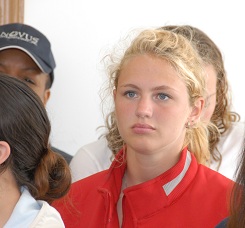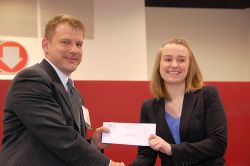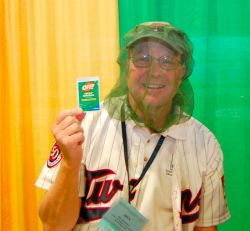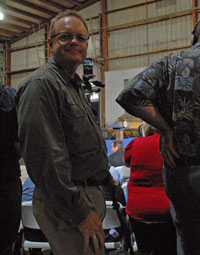 One of the big highlights of Novus International’s 2nd annual “Science: A Foundation for Dynamic Careers” days was the time the students were able to spend with the horses at Novus’ research farm … AKA Green Acres. And let’s face it, meeting the Missouri Colleges Fund scholars sure seemed to be a treat for the horses.
One of the big highlights of Novus International’s 2nd annual “Science: A Foundation for Dynamic Careers” days was the time the students were able to spend with the horses at Novus’ research farm … AKA Green Acres. And let’s face it, meeting the Missouri Colleges Fund scholars sure seemed to be a treat for the horses.
One person who dived right in, literally both hands, was Hannibal-LaGrange College in Hannibal, Mo. junior Hannah Crain … who it was easy to tell has horses of her own (gotta love the expression on her face … and the face of the horse!).
But while giving the horse a good rub down was fun, she says she was most impressed with Novus’ commitment to the environment.
“Today, I’ve been learning about the importance of using and protecting what your environment has given you,” and she’s impressed with how Novus is helping to take care of the Earth, while building the ag economy.
 Crain, who is majoring in biology education and pre-med, sees a real, practical application of what she’s learning at Novus.
Crain, who is majoring in biology education and pre-med, sees a real, practical application of what she’s learning at Novus.
“[The farm] shows that they care about real-life applications and that they are trying to connect with the general public and their customers and are willing to do everything they can to make products that are safe and healthy.”
She says Novus is definitely the kind of place she could see herself working at one day. Maybe if they give her her own horse, that might seal the deal!
Hear more of my interview with Hannah below.
2010 Novus International Science: A Foundation for Dynamic Careers Photo Album
![]() Food safety. Pretty important topic isn’t it?
Food safety. Pretty important topic isn’t it?





 “I feel like I’ve made 300 of the best friends I’ve ever had,” said Paul Mobley, author of the new photographic book, “American Farmer” when describing how photographing farmers around America has changed his life. Paul never set out to put together a collection of photos taken of farmers around the world – he happened upon the opportunity when he went up to his cabin to get away from his career as a portrait photographer.
“I feel like I’ve made 300 of the best friends I’ve ever had,” said Paul Mobley, author of the new photographic book, “American Farmer” when describing how photographing farmers around America has changed his life. Paul never set out to put together a collection of photos taken of farmers around the world – he happened upon the opportunity when he went up to his cabin to get away from his career as a portrait photographer. I had the opportunity to speak with Paul after the closing luncheon during the 2010 NAMA conference. I asked him how this book has changed his life. “I feel like its changed me on so many levels….I walk the earth with so much kindness grace and humility and I got it all from you guys,” he said.
I had the opportunity to speak with Paul after the closing luncheon during the 2010 NAMA conference. I asked him how this book has changed his life. “I feel like its changed me on so many levels….I walk the earth with so much kindness grace and humility and I got it all from you guys,” he said.


